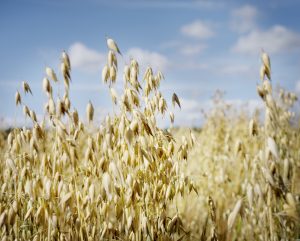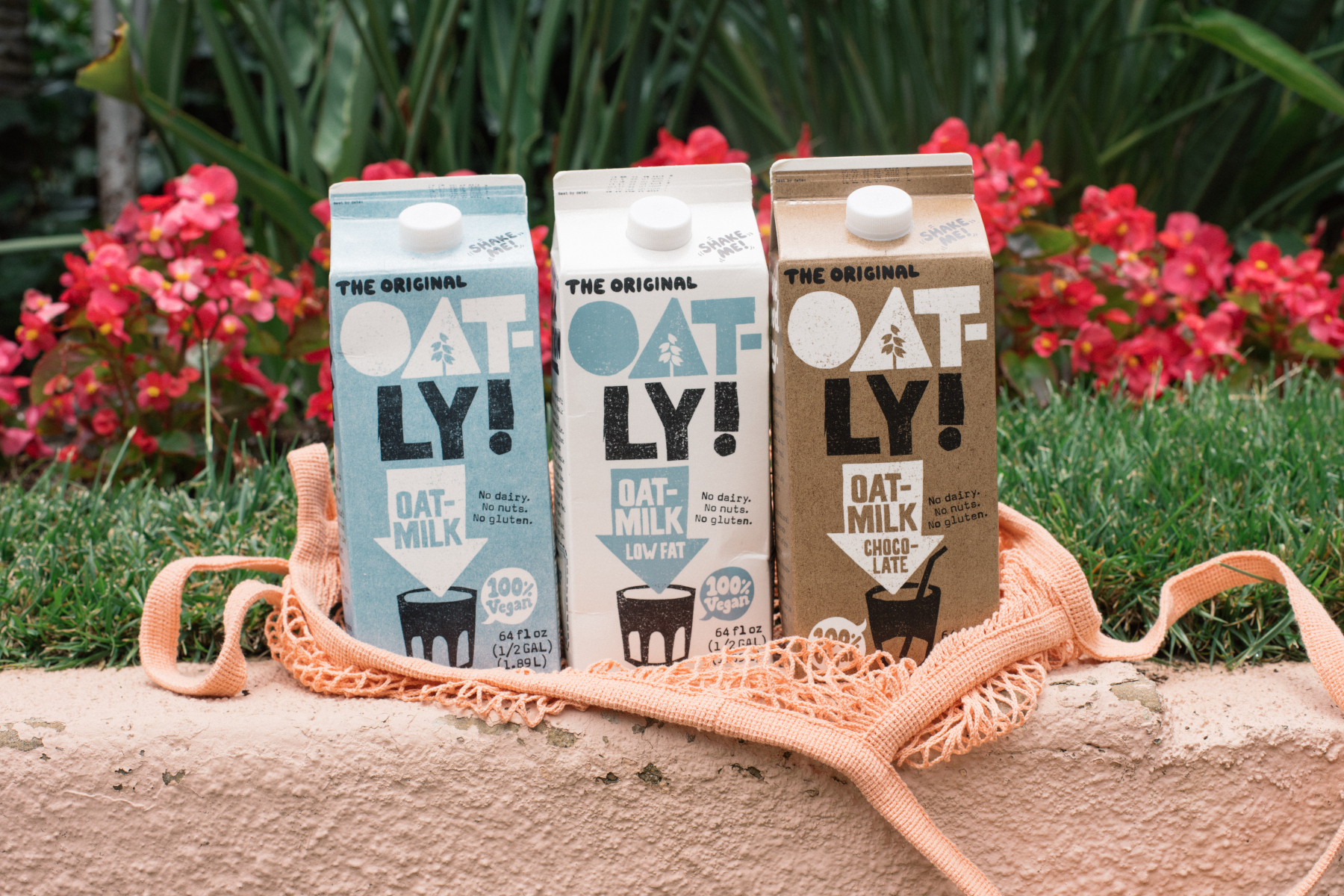Plant-based beverage sales are skyrocketing—U.S. retail sales topped $2 billion in 2017, while overall market demand reached $9.8 billion last year. A Cargill study found that 50 percent of households buy both cow’s milk and non-dairy alternatives.
As consumers seek cow’s milk substitutes for various reasons, they’ve had choices—almond, soy, coconut, cashew, or hemp—and now oat milk. While soy and almond milks have had setbacks in popularity, oat milk is enjoying a meteoric rise. Plant-based options comprise less than 5 percent of beverage sales overall, but oat milk constitutes 40 percent of that.
Swedish company Oatly launched 25 years ago when Lund University researcher Rickard Öste developed a tasty, nutritionally balanced oat beverage as a dairy alternative. In early 2017, Oatly introduced its oat milk at 15-20 urban U.S. coffee shops; two years later, several thousand cafes serve it daily. Demand is so strong it’s been hard to fill orders. “The magnitude of the demand and the speed with which it developed vastly exceeded our expectations,” Oatly’s U.S. general manager Mike Messersmith told FoodNavigator USA.
Oatly products in the U.S. include Original, Low-Fat, Chocolate, and a Barista edition. Between 1500 and 2000 U.S. groceries offer them, including Wegman’s, Whole Foods, and Target. Oatly products contain no nuts, gluten, added sugar, or dairy; they are certified vegan, gluten-free, kosher and non-GMO by the Non-GMO Project. The creamier texture and higher fat content of the Barista version results in thicker foam, excellent for making “latte art.”
“Consumers now don’t have to compromise on nutrition, taste, or transparency—they want all of those,” Messersmith said.
Oatly’s practical, transparent approach
“Oatly epitomizes many Swedish traits—super practical, honest and open, hardworking, and independent,” Messersmith said. “We chose oats because they’re an excellent cover crop and relatively easy to grow across many geographic regions—from dark, rainy Sweden to the fertile Midwest—without a lot of irrigation or pesticides.”
Grain Millers, a North American grain producer, provides the high quality, gluten-free oats for Oatly’s North American production. Grain Millers requires its growers to sign an affidavit not to spray oats with glyphosate—a pre-harvesting practice that has resulted in consumers ingesting large amounts of the herbicide, which is the main ingredient in Bayer’s Roundup. The Detox Project certifies Oatly’s finished product as glyphosate-free, with testing done randomly each week.
Oatly uses non-GMO, expeller pressed canola oil sourced from North America and the Netherlands; no hexane is used in processing. “Our product standards are high,” added Messersmith. “If we set a high bar, hopefully other manufacturers will be forced to achieve it as well.”
The manufacturing process begins with milling a simple mixture of oats and water, then adding natural enzymes to break down the starch. The bran is removed, leaving the soluble fiber; to this oat base is added sea salt, vitamins, calcium, cocoa powder (for the chocolate version), and rapeseed (canola) oil. The mixture is heated, kept sterile, and then packaged with recyclable materials.
The company is scaling up production and plans for its capacity to catch up to demand within the next six months. A new 20,000 square-foot processing plant will open in Spring 2019 in Millville, New Jersey—ramping up production eight- to ten-fold, weekly.
Oats are nutritionally rich and contain beta-glucans—soluble fiber that helps lower cholesterol and improve heart health. Oatly chose not to go organic but focused instead on gluten-free, because the U.S. market’s price point was too high for gluten-free, organic oats—café browsers already spend an extra $.75 to $1.00 to add oat milk to their drinks.
Oatly currently has 30 U.S. employees. The open, flexible corporate culture “allows us to move fast as a small company,” Messersmith said. “That responsiveness is an advantage.”
Changing the face of U.S. farming?
As the market for oat milk grows, Midwest U.S. farmers have an incentive to add oats to their crop rotations. This could “change everything” for agriculture’s environmental impact, said sustainable food writer Tom Philpott.
Messersmith agrees that oats could aid Midwestern growers. “It’s exciting to see how oats could improve soil health, finances, and the environmental footprint,” he said. “The commodities market today is under pressure, and if we can help them solve some of their problems by incentivizing growing high quality oats, all the better.”
A new study published in January found that adding oats, red clover, and alfalfa to corn and soybean rotations brought significant benefits including reduced fertilizer runoff, soil erosion, and herbicide use.
Crop insurance and agricultural subsidies have kept farmers locked into the corn and soybean monoculture, but raising consumer awareness through sustainable products like oat milk could create an agricultural shift.
“It’s a net gain socially,” said Sarah Carlson of Practical Farmers of Iowa. “You’ve protected your soil asset, cleaned up water, and provided habitat” for wildlife. But to make the shift farmers need to know they’ll have a buyer for the crops. Grain Millers has actively requested more oats from Iowa and Minnesota growers, recently adding more storage capacity.
Carlson added that large meat processors like Tyson and Smithfield could change the crop landscape overnight by shifting oats into a larger portion of animal feed.
Competitors signal ongoing market growth
Several large beverage players have entered the oat milk market. Silk recently launched Oat Yeah oat milk. Quaker Oats is planning its Quaker Oat Beverage debut. Califia Farms introduced a barista oat milk in February. Mooala just launched an organic oat milk that contains zero sugar. Vegan dessert brand So Delicious recently introduced a range of oat milk ice cream products. Yogurt maker Nancy’s now sells oat milk yogurt products. Even furniture manufacturer IKEA offers Munsbit oat smoothies at its in-store food shops.
Oatly may introduce some of its international products to the U.S. eventually, including organic oat milk, oatgurt, kids’ drinks, orange mango oat drinks, and oat spreads.
If oat milk continues its impressive rise, the nation’s soils could benefit as much as consumers thirsty for meaningful, nutritious products.
Study: Diversified crop rotations with oats reduces fertilizer runoff, erosion while increasing yields and farm profits

Oat milk is encouraging more production of oats, which could help improve soil health on Midwest farms
Fertilizer runoff and soil erosion from large corn and soybean farms in the Midwest can cause environmental damage, such as the massive “dead zone” in the Gulf of Mexico. But a newly published study by researchers at Iowa State University and the University of Minnesota finds that adding more crops such as oats to the corn-soybean crop rotation can reduce runoff and erosion while increasing crop yields and farm profitability.
The researchers, which included Matt Liebman of Iowa State and Natalie Hunt and Jason Hill of the University of Minnesota, compared the effects of a 2-year corn and soybean rotation with a 3-year corn-soybean-oat/clover rotation and a 4-year corn–soybean–oat/alfalfa–alfalfa rotation.
The researchers found that nitrogen and phosphorus fertilizer runoff was 39 percent lower in the 3-year rotation and 30 percent lower in the 4-year rotation than the 2-year rotations. Soil erosion was also up to 60 percent less in the longer crop rotations. They also found that corn yields in the 3- and 4-year crop rotations were 4.5 percent higher than the 2-year rotations.
In summary, the researchers wrote: “These results indicate that diversifying the corn–soybean rotation that dominates the central United States could reduce water nutrient contamination and soil erosion while maintaining farm productivity and profitability.”
The study was published in the January 2019 issue of Environmental Science and Technology.
The full paper is available at: https://pubs.acs.org/doi/10.1021/acs.est.8b02193









